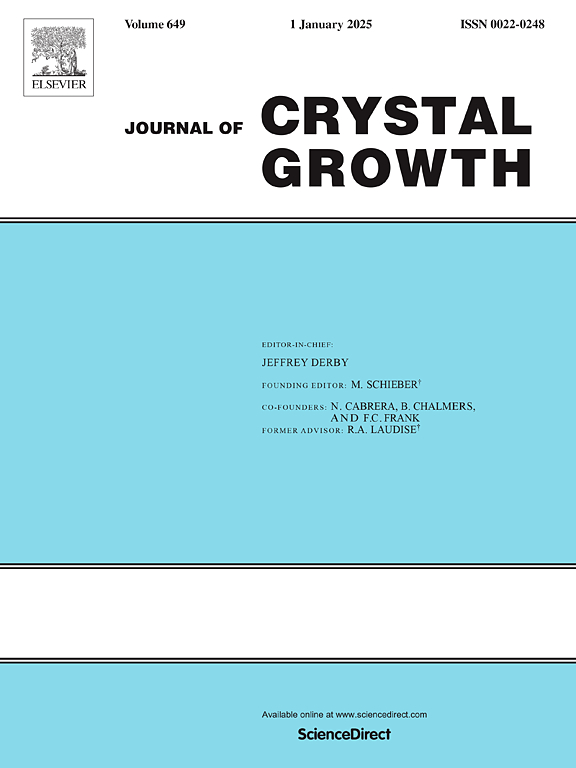Influence of substrate atomic symmetry on the epitaxy and rotational domain formation of κ-Ga2O3
IF 2
4区 材料科学
Q3 CRYSTALLOGRAPHY
引用次数: 0
Abstract
This study systematically explores the structural factors influencing κ-phase gallium oxide (κ-Ga2O3) thin film growth and domain formation on non-basal plane substrates. Accordingly, we grew κ-Ga2O3 thin films using mist chemical vapor deposition on both basal and non-basal plane sapphire (c-, a-, m-, and r-plane) and GaN (c- and m-plane) substrates for analysis. Crystallinity, orientation, and domain structures were assessed by X-ray diffraction including 2θ–ω scans, rocking curves, and φ-scans. On c- and a-plane sapphire and GaN substrates, κ-Ga2O3 with c-axis orientation was selectively stabilized, whereas α-Ga2O3 predominantly formed on r- and m-plane sapphire. Regardless of substrate symmetry, all κ-Ga2O3 films exhibited persistent three-fold rotational domains, highlighting the limitations of current substrate configurations. These results demonstrate the significant influence of substrate atomic arrangement on phase stability and domain control, emphasizing the need for advanced substrate engineering to realize single-domain κ-Ga2O3 thin films with improved crystalline quality.
衬底原子对称对κ-Ga2O3外延和旋转畴形成的影响
本研究系统探讨了影响κ相氧化镓(κ-Ga2O3)薄膜在非基面基底上生长和畴形成的结构因素。因此,我们使用雾状化学气相沉积方法在基面和非基面蓝宝石(c-, a-, m-和r-面)和GaN (c-和m-面)衬底上生长了κ-Ga2O3薄膜进行分析。通过x射线衍射(包括2θ -ω扫描、摇摆曲线和φ扫描)评估了结晶度、取向和畴结构。在c面和a面蓝宝石和GaN衬底上,具有c轴取向的κ-Ga2O3选择性稳定,而α-Ga2O3主要在r面和m面蓝宝石上形成。不管衬底的对称性如何,所有的κ-Ga2O3薄膜都表现出持续的三重旋转畴,这突出了当前衬底结构的局限性。这些结果表明,衬底原子排列对相稳定性和畴控制有重要影响,强调需要先进的衬底工程来实现具有更高结晶质量的单畴κ-Ga2O3薄膜。
本文章由计算机程序翻译,如有差异,请以英文原文为准。
求助全文
约1分钟内获得全文
求助全文
来源期刊

Journal of Crystal Growth
化学-晶体学
CiteScore
3.60
自引率
11.10%
发文量
373
审稿时长
65 days
期刊介绍:
The journal offers a common reference and publication source for workers engaged in research on the experimental and theoretical aspects of crystal growth and its applications, e.g. in devices. Experimental and theoretical contributions are published in the following fields: theory of nucleation and growth, molecular kinetics and transport phenomena, crystallization in viscous media such as polymers and glasses; crystal growth of metals, minerals, semiconductors, superconductors, magnetics, inorganic, organic and biological substances in bulk or as thin films; molecular beam epitaxy, chemical vapor deposition, growth of III-V and II-VI and other semiconductors; characterization of single crystals by physical and chemical methods; apparatus, instrumentation and techniques for crystal growth, and purification methods; multilayer heterostructures and their characterisation with an emphasis on crystal growth and epitaxial aspects of electronic materials. A special feature of the journal is the periodic inclusion of proceedings of symposia and conferences on relevant aspects of crystal growth.
 求助内容:
求助内容: 应助结果提醒方式:
应助结果提醒方式:


